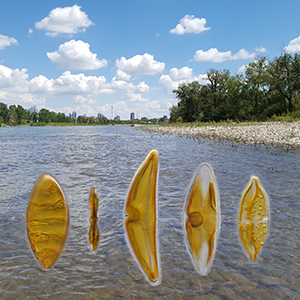Exploring diatom diversity through cultures - a case study from the Bow River, Canada

Accepted: 18 November 2022
HTML: 11
All claims expressed in this article are solely those of the authors and do not necessarily represent those of their affiliated organizations, or those of the publisher, the editors and the reviewers. Any product that may be evaluated in this article or claim that may be made by its manufacturer is not guaranteed or endorsed by the publisher.
Authors
Diatom cultures can help answer taxonomic, biogeographic and ecological questions on a local and global scale. Unialgal cultures are derived from a single cell and provide abundant material for morphological and molecular analyses. The link between the historic morphological species concept and the molecular data is becoming increasingly important with the use of eDNA metabarcoding. Additionally, cultures provide insights into the life cycle of diatoms and thereby complement taxonomy and species ecology. In this study, we present an approach to extract benthic diatoms from an environmental sample to generate unialgal cultures. We explored diatom diversity in preserved assemblages and by culturing as many different taxa as possible from benthic freshwater samples taken on the same day from the Bow River in Calgary, Canada. With both methods we found a total of 221 different benthic diatom taxa, of which 182 were identified in the preserved diatom assemblages. Interestingly, an additional 39 taxa only appeared in the cultures. In total 129 strains were cultivated representing 71 different taxa. This study includes pictures of living cells demonstrating the additional merits of unialgal cultures, as they provide information on plastid details, auxospores and endosymbionts. Both, the identification of the diatom assemblages and the generation and identification of strains provide the foundation for additional water quality assessment tools, taxonomic insights and molecular references libraries.
Edited by
Francesca Bona, Department of Life Sciences and Systems Biology, University of Turin, ItalySupporting Agencies
Verein der Freunde des Botanischen Gartens und Botanischen Museums Berlin Dahlem e.V. , Federal Ministry of Education and Research (German Barcode of Life 2 Diatoms, GBOL2)How to Cite

This work is licensed under a Creative Commons Attribution-NonCommercial 4.0 International License.
Similar Articles
- Mau Trinh Dang, Hendrik Segers, La-orsri Sanoamuang, Rotifers from Thuy Tien lake and Nhu Y river in central Vietnam, with a description of Ploesoma asiaticum new species (Rotifera: Monogononta) , Journal of Limnology: Vol. 72 No. s2 (2013): Freshwater Invertebrates of Southeast Asia
- Rossano Bolpagni, Mattia M. Azzella, Chiara Agostinelli, Andrea Beghi, Eugenia Bettoni, Guido Brusa, Cristina De Molli, Riccardo Formenti, Filippo Galimberti, Bruno E.L. Cerabolini, Integrating the Water Framework Directive into the Habitats Directive: Analysis of distribution patterns of lacustrine EU habitats in lakes of Lombardy (northern Italy) , Journal of Limnology: Vol. 76 No. s1 (2017): Aquatic biomonitoring: Lessons from the past, challenges for the future
- Barbara Leoni, Zooplankton predators and prey: body size and stable isotope to investigate the pelagic food web in a deep lake (Lake Iseo, Northern Italy) , Journal of Limnology: Vol. 76 No. 1 (2017)
- Külli Kangur, Peeter Kangur, Kai Ginter, Kati Orru, Marina Haldna, Tõnu Möls, Andu Kangur, Long-term effects of extreme weather events and eutrophication on the fish community of shallow Lake Peipsi (Estonia/Russia) , Journal of Limnology: Vol. 72 No. 2 (2013)
- Andrew L. Labaj, Joshua Kurek, Russ C. Weeber, John P. Smol, Long-term changes in invertebrate size structure and composition in a boreal headwater lake with a known minnow introduction , Journal of Limnology: Vol. 72 No. 2 (2013)
- Sarma Nandini, Pedro Ramirez García, S.S.S. Sarma, Water quality in Lake Xochimilco, Mexico: zooplankton indicators and Vibrio cholerae , Journal of Limnology: Vol. 75 No. 1 (2016)
- Stefan Weinberger, Mark Vetter, Lake heat content and stability variation due to climate change: coupled regional climate model (REMO)-lake model (DYRESM) analysis , Journal of Limnology: Vol. 73 No. 1 (2014)
- Anna B. Sikora, Piotr Dawidowicz, Eric von Elert, Daphnia fed algal food grown at elevated temperature have reduced fitness , Journal of Limnology: Vol. 73 No. 3 (2014)
- Germán Pérez, Laura Farías, Camila Fernandez, Daniel Conde, Claudia Piccini, Incidence of phytoplankton and environmental conditions on the bacterial ammonium uptake in a subtropical coastal lagoon , Journal of Limnology: Vol. 73 No. 1 (2014)
- Diego de Jesus Chaparro-Herrera, Sarma Nandini, S.S.S. Sarma, Effect of water quality on the feeding ecology of axolotl Ambystoma mexicanum , Journal of Limnology: Vol. 72 No. 3 (2013)
<< < 37 38 39 40 41 42 43 44 45 46 > >>
You may also start an advanced similarity search for this article.
-
Katherina Schimani, Nélida Abarca, Oliver Skibbe, Heba Mohamad, Regine Jahn, Wolf-Henning Kusber, Gabriela Laura Campana, Jonas ZimmermannMetabarcoding and Metagenomics : 2023

 https://doi.org/10.4081/jlimnol.2022.2095
https://doi.org/10.4081/jlimnol.2022.2095





